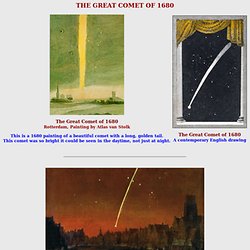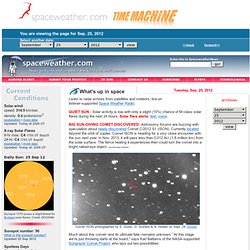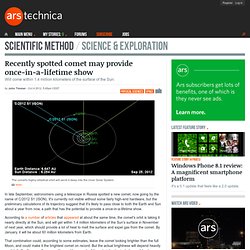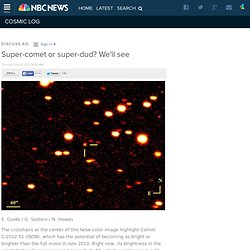

Comet ISON Celestial Show in November 2013. THE GREAT COMET OF 1680. Background and Additional Information On November 14, 1680, Gottfried Kirch detected a new comet, becoming on that day the first person to discover a comet using a telescope.

Astronomers throughout Europe tracked its position for several months. Big Comet Inbound! Comet ISON / C/2012 S1. Time Machine. QUIET SUN : Solar activity is low with only a slight (15%) chance of M-class solar flares during the next 24 hours.

Solar flare alerts: text, voice. BIG SUN-DIVING COMET DISCOVERED: Astronomy forums are buzzing with speculation about newly-discovered Comet C/2012 S1 (ISON). Currently located beyond the orbit of Jupiter, Comet ISON is heading for a very close encounter with the sun next year. In Nov. 2013, it will pass less than 0.012 AU (1.8 million km) from the solar surface. SOHO and STEREO Sungrazing Comets. New Comet: C/2012 S1 (ISON) Cbet nr. 3238, issued on 2012, September 24, announces the discovery of a new comet (discovery magnitude 18.8) by Vitali Nevski (Vitebsk, Belarus) and Artyom Novichonok (Kondopoga, Russia) on CCD images obtained on Sept. 21.06 UT with a 0.4-m f/3 Santel reflector of the International Scientific Optical Network (ISON) near Kislovodsk, Russia.

JPL Small-Body Database Browser. Recently spotted comet may provide once-in-a-lifetime show. In late September, astronomers using a telescope in Russia spotted a new comet, now going by the name of C/2012 S1 (ISON).

It's currently not visible without some fairly high-end hardware, but the preliminary calculations of its trajectory suggest that it's likely to pass close to both the Earth and Sun about a year from now, a path that has the potential to provide a once-in-a-lifetime show. According to a number of articles that appeared at about the same time, the comet's orbit is taking it nearly directly at the Sun, and will get within 1.4 million kilometers of the Sun's surface in November of next year, which should provide a lot of heat to melt the surface and expel gas from the comet. By January, it will be about 60 million kilometers from Earth.
New comet might blaze brighter than the full Moon. New comet might blaze brighter than the full Moon BY PETER GREGOASTRONOMY NOWPosted: 25 September 2012 File photo of Comet Hale-Bopp which wowed observers in 1997.

Image: Kazuhiro Seto. A new comet has been discovered that is predicted to blaze incredibly brilliantly in the skies during late 2013. With a perihelion passage of less than two million kilometres from the Sun on 28 November 2013, current predictions are of an object that will dazzle the eye at up to magnitude —16. “Once in a Civilization” Comet to Zip past Earth Next Year. Newly spotted comet may outshine the full moon. Jeff Hecht, contributor (Image: E.

Guido, G. Sostero, N. Howes) New Comet Discovered—May Become "One of Brightest in History" If astronomers' early predictions hold true, the holidays next year may hold a glowing gift for stargazers—a superbright comet, just discovered streaking near Saturn.

Even with powerful telescopes, comet 2012 S1 (ISON) is now just a faint glow in the constellation Cancer. But the ball of ice and rocks might become visible to the naked eye for a few months in late 2013 and early 2014—perhaps outshining the moon, astronomers say. The comet is already remarkably bright, given how far it is from the sun, astronomer Raminder Singh Samra said. Asteroids and Comets, Asteroids and Comets Information. Rogue Remnants Though too small to earn the distinction of planet, asteroids and comets strike huge fear in the human mind.

And for good reason: at some point in the future, one of the chunky rocks or icy mud balls will slam into Earth and alter the course of history. Such an impact 65 million years ago is widely believed to have killed off the dinosaurs. Asteroids and comets are considered remnants from the giant cloud of gas and dust that condensed to create the sun, planets, and moons some 4.5 billion years ago. Today, most asteroids orbit the sun in a tightly packed belt located between Mars and Jupiter. The distinction between asteroids and comets is fuzzy—comets tend to have more chemical compounds that vaporize when heated, such as water, and more elliptical (egg-shaped) orbits than asteroids do.
Asteroid Belt Asteroids are essentially chunks of rock that measure in size from a few feet to several miles in diameter. Astronomers Discover Huge Comet Hurtling Towards Us. Met 'brighter than the moon' will fly-by the Earth in 2013. By Eddie Wrenn Published: 08:45 GMT, 27 September 2012 | Updated: 13:28 GMT, 27 September 2012.

Super-comet or super-dud? We'll see. E.

Guido / G. Sostero / N. Howes. Will It Be Spectacular? The astronomy community was abuzz with news about a comet discovery on Tuesday , leading to speculation that it could make a spectacular flyby of the sun, giving Earth a ringside seat of an extremely bright celestial event. It could become so bright that it even outshines the moon . On the other hand, it might not. Confused?